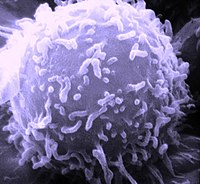
Photo from wikipedia
BACKGROUND Periodontitis is a common chronic inflammatory disorder that affects supporting tissues of the teeth. An increased risk of pregnancy complications has been reported in patients with periodontitis; however, its… Click to show full abstract
BACKGROUND Periodontitis is a common chronic inflammatory disorder that affects supporting tissues of the teeth. An increased risk of pregnancy complications has been reported in patients with periodontitis; however, its pathophysiology remains uncharacterized to date. In addition, Porphyromonas gingivalis (Pg) is detectable in a few placentae derived from diseased pregnancies. Thus, the aim of this study is to examine the roles of soluble factors produced by Pg on trophoblast invasion in vitro to clarify the remote effects of periodontitis on pregnancy outcomes. METHODS The immortalized trophoblast cell line HTR-8/SVneo was cultured on plates or via hanging drop to evaluate viability, apoptosis, and morphology in the presence of the culture supernatant of Pg (PG-sup). Cells were plated on solubilized extracellular matrix rich membrane preparation plates to evaluate cell invasion. Morphologic changes were evaluated via stereomicroscopy, optical microscopy, and transmission electron microscopy. RESULTS After 24 hours of culture, cell invasion was inhibited by PG-sup in a dose-dependent manner. Although cell viability and apoptotic counts were not affected by PG-sup, spheroid formation in hanging drop culture was inhibited. Spheroids became fragile and irregular in the presence of PG-sup. Transmission electron microscopy revealed shortened microvilli and increased intracellular spaces. CONCLUSIONS PG-sup inhibits trophoblast invasion and affects trophoblast morphology without direct cytotoxicity. These results indicate that Pg produces soluble factor(s) that suppress trophoblast invasion and subsequent vascular remodeling, which affect placental growth and fetal well-being. It is expected that the current findings will explain the increased prevalence of pregnancy complications in patients with periodontitis.
Journal Title: Journal of Periodontology
Year Published: 2017
Link to full text (if available)
Share on Social Media: Sign Up to like & get
recommendations!